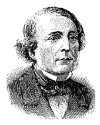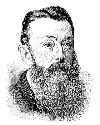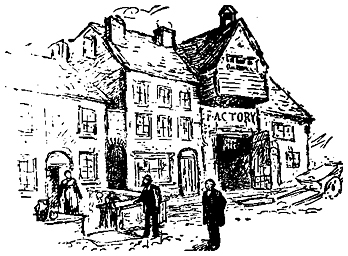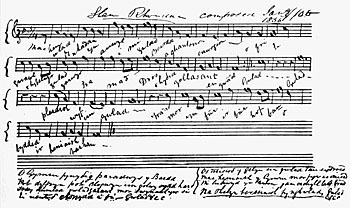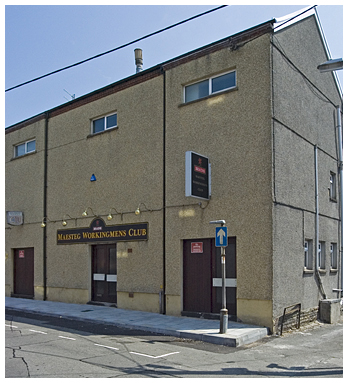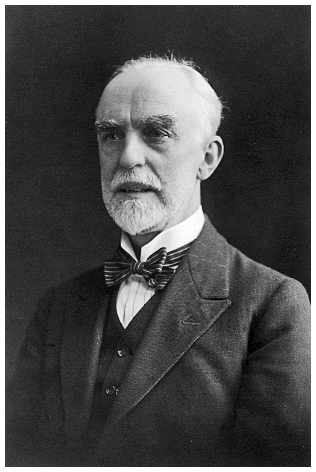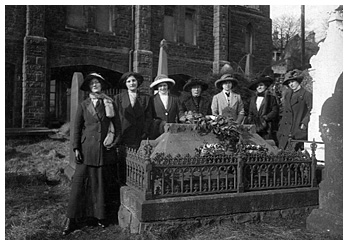
The History of the National Anthem |
|
| The Story of The Welsh National Anthem - Hen Wlad fy Nhadau - The Land of My Fathers | |
Evan James |
James James |
| Background | |
| The Welsh National Anthem Hen Wlad Fy Nhadau (Land of my Fathers) is amongst the finest anthems of the world and a song steeped in history. It was written by Evan James and his son James, two modest tradesmen living at Pontypridd in the mid nineteenth century. Evan James was born in 1809 at Caerphilly but moved when only four years old to live at the Ancient Druid Inn near Argoed in the parish of Bedwellty. A weaver by trade, he installed his own loom near the inn and spent the early years of his married life as both landlord and weaver. His son James, one of seven children, was also born there in 1832. Evan James and his family came to Pontypridd in 1847 to run a woollen factory on the banks of the river Rhondda. He remained there until his death in 1878. James James left Pontypridd for Mountain Ash and later moved to Aberdare in 1893 where he died in 1902. | |
| Evan James spent many hours reading literature and composing simple poetry. It is said that even whilst working he always kept a slate beside him should he feel the need to write some thoughts. We also gather that from an early age James showed a natural gift for music and became fond of the harp. Thus father and son would happily spend long evenings, the one composing verses and the other playing music. |
The Mill Street Factory of Evan James
|
The birth of the Welsh National Anthem |
|
| There seems to be general agreement that the tune was composed in January 1856. This date is written on the earliest copy in existence, a manuscript in the handwriting of the composer James James, which is kept at the National Library of Wales, Aberystwyth. The circumstances of the anthem's composition however are somewhat uncertain. A mystery remains to this day as to whether it was the poem or the music that came first. Unfortunately we have no reliable record and not surprisingly contradictory accounts circulate today. One of these state that the words of Hen Wlad Fy Nhadau were written as Evan James's response to his brother's invitation to join him in America. He gives the words to James and they inspire him to music. | |
| Taliesin James, son of James James, gives another account in a letter addressed to John Crockett of Pontypridd. Dated December 1910, he writes that James first composed the tune whilst walking along the river Rhondda and asks his father to write verses for it. Whatever the truth, the father and son appropriately named their song Glan Rhondda as it was composed on the banks of this river. |
Anthem Sheet Music
|
The Anthem's early years |
|
| Although not officially nor legally recognised as the Welsh National Anthem, Hen Wlad Fy Nhadau was considered as such among the Welsh populace well before the end of the nineteenth century. Unlike many anthems it hadn't been commissioned to mark a particular occasion. Rather it had gradually gained acceptance and secured its place each time it was played. A 16 year old girl from Pontypridd named Elizabeth John first publicly performed the song in the Vestry of Tabor Methodist Chapel, now a Workingman's Club, in Maesteg. According to an article written by the journalist and druid Owen Morgan (Morien) that appeared in the Western Mail (April 4 th , 1884) James James also sang the song himself in an Eisteddfod held at the Castell Ifor Inn, Hopkinstown. Other sources inform us that he sang the melody at the Gorsedd ceremony of the Pontypridd Eisteddfod held on Pontypridd Common in 1857. |
Maesteg Workingman's Club which once was Tabor Methodist Chapel - the site of the first performance of the Welsh National Anthem |
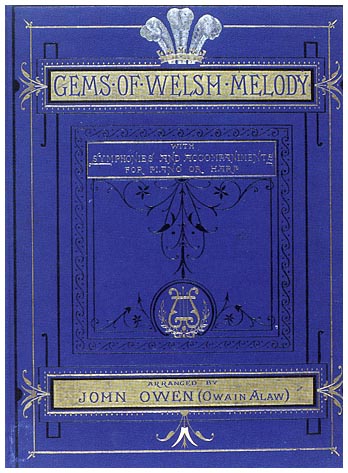 |
It became more widely known following the 1858 Llangollen National Eisteddfod. A competition at the eisteddfod called for a collection of unpublished Welsh airs. Thomas Llewelyn (Llewelyn Alaw) of Aberdare included Glan Rhondda in his selection and shared first prize. The song made an impression on John Owen (Owain Alaw), the adjudicator and accomplished musician. He decided to include the words and music in his collection, Gems of Welsh Melody , published by Isaac Clarke of Ruthin in 1860. He also arranged the melody for four voices and entitled it Hen Wlad Fy Nhadau. Although we're fairly certain that the words and music appeared in a book for the first time with the publication of Gems of a Welsh Melody , there is also a ballad sheet preserved at Pontypridd Library, which according to words written upon it, was printed by F. Evans of Pontypridd in 1858. The authenticity of the date requires further examination. |
John Owen sang Hen Wlad Fy Nhadau at numerous concerts all over North Wales. Having a rousing chorus and easily learnt, it became very popular with Eisteddfod followers. Seeing audiences' responses, the great soloists of the day sang it themselves with gusto. At the 1866 Chester Eisteddfod Lewis William Lewis (Llew Llwyfo) sang it according to the historian Dr John Davies with remarkable effect. He claims in his publication A History of Wales that “Hen Wlad Fy Nhadau …. was sung with such passion that it was adopted forthwith as the national anthem”. It was sung to close every session at this event and every eisteddfod thereafter. Nine years later Wales's leading soloist Robert Rees (Eos Morlais) sang it at Bangor National Eisteddfod. His performance, according to the Baner ac Amserau Cymru journal “had taken the Eisteddfod by storm”. Hen Wlad Fy Nhadau was recognised as the Eisteddfod song at the Caernarfon Eisteddfod of 1880 and sung at every Gorsedd ceremony ever since. The Hen Wlad Fy Nhadau cause received a further boost at the National Eisteddfod held at London's Albert Hall in 1887. Having succeeded on a number of occasions to excuse himself from visiting the Eisteddfod, Prince Albert Edward, Prince of Wales could hardly avoid this one. Eos Morlais lead the singing of God Bless The Prince of Wales as the prince arrived. At the end of the meeting Eos rose to sing Hen Wlad Fy Nhadau . Albert and his family got up too and stood while the anthem was sung. We don't know the reason why he rose but royalty had stood for the Welsh National Anthem. At the end of the nineteenth century the anthem took another significant step. The first commercial recording of Welsh songs was made in London on March 11 th 1899 and released by the Gramophone Company. Hen Wlad Fy Nhadau was among those songs. |
|
| Commemorating the Welsh National Anthem in Pontypridd | |
| Pontypridd town's commemoration of the Welsh National Anthem's author and composer originated in 1909. It was in April of that year that Pontypridd Grammar School's first headmaster, Mr Rhys Morgan, addressed the Pontypridd Cymmrodorion Society and argued for establishing a worthy memorial to Evan James and James James. A few weeks later on June 10 th 1909, a public meeting was held at the Municipal Buildings. A committee was appointed that included Councillor Hopkin Morgan as chairman and Mr Rhys Morgan and Mr J Colenso Jones as joint secretaries. However, it wasn't until over twenty years later that Mr Rhys Morgan's vision of commemorating Evan and James James was finally achieved. Read the Council letter.
The project started brightly enough. A report about the first meeting of the General Committee and a list of subscriptions appeared in the Pontypridd Observer at the end of June 1909. Circulars were sent out and concerts held with the aim of obtaining funds. Henry Davies even went to the United States in June 1913 to raise funds from Welsh-Americans although we see from the Observer that on his return he suffered the indignity of having to deny rumours that he'd spent some of the funds raised whilst there. Five years after the launch of the campaign the committee's target remained unmet. The public's generosity was drawn towards Senghenydd following the appalling mining disaster in October 1913. Its death knell however was the outbreak of the First World War that signalled the abandonment of the campaign. |
|
Sir W Goscombe John
|
Post war conditions made re-establishing the campaign difficult. Not until 1928 did the artist Sir W Goscombe John attended a meeting of the fund committee with a small model of a memorial that he thought would be fitting. Although his suggestion was approved, a sum of £500 was required to enable the committee to close the campaign. After several months of little success, Mr Rhys Morgan decided to discuss the matter with Sir William Davies, editor of the Western Mail. An appeal appeared in the publication on June 29 th 1929 that deserved a “prompt response” from every “Welsh man or woman”. The money was collected in a very short time. By May 1930 Sir W Goscombe John had almost completed his work. A letter and a photograph that he sent to secretaries of the Hen Wlad Fy Nhadau Memorial shown below illustrate that the memorial would consist of two bronze figures, one representing music and the other poetry. The completed monument was to be mounted on a pedestal of blue pennant stone from the nearby Graig yr Hesg Quarry. |
On July 23 rd 1930 the unveiling of the memorial to Evan James and James James took place at Ynysangharad Park. In the words of the Observer, it was a “Red Letter day in the history of Pontypridd”. As shown below on the invitations given that day, a procession formed outside the Municipal Buildings and marched to Ynysangharad Park where about 10,000 people had assembled. Lord Treowen unveiled the memorial in the presence of the Archdruid ‘Pedrog' and other members of the Gorsedd. A year following the unveiling of the memorial in Ynysangharad Park, a marble tablet was erected in Mill Street, Pontypridd marking the place where Evan James's woollen factory once stood. Unfortunately the tablet was later damaged during building works and a far more indistinctive tablet remains at the side of the building today. The tablet's unveiling in 1931 was the culminating point of a project started over twenty years previously by Mr Rhys Morgan and the Pontypridd Cymmrodorion Society as the minutes of the Pontypridd Urban District Council show. An important year in Pontypridd town's commemoration of the National Anthem was 1956. A week of commemorative services and celebrations were held during the anthem's centenary year that included religious services, singing festivals, school concerts, sports days and a ten-mile race between Mountain Ash and Pontypridd. The culmination was a celebrity concert including a performance by Cilfynydd's world famous opera singer Geraint Evans. Beyond Pontypridd the Western Mail sponsored a Schools' Essay competition. Unsurprisingly, the subject of the essay was “The Welsh National Anthem” or “Yr Anthem Genedlaethol Cymraeg” (sic.). |
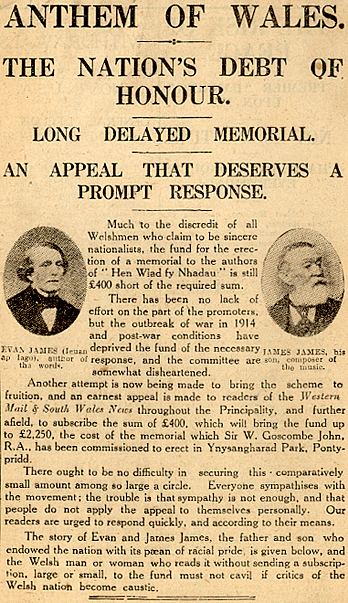 |
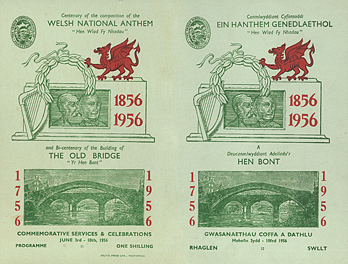 |
A few days before the anthem centenary celebration week the Western Mail reported that visitors who came to see Evan James grave at Carmel Baptist Chapel Pontypridd were shocked at the derelict state of the graveyard. Mr William Gilmore, a deacon at Carmel Chapel, began a project with the assistance of the Pontypridd Rotary Club to transform the churchyard into a Garden of Remembrance. Events were held in order to raise funds including concerts and a rugby match that was staged in the town park. Despite generous donations received from the Rotary Club and Glamorgan County Council, the task of securing enough funds was proving difficult. An appeal by the Reverend Haydn Lewis of Ton Pentre at Llanelli National Eisteddfod in 1962 raised only £10. |
Sadly, unlike the Ynysangharad Park memorial, the Garden of Remembrance didn't have a successful outcome. Carmel Chapel was demolished in late 1969 and the Garden of Remembrance left in a derelict condition. The reports show (click here) the arguments that ensued about exhuming and reburying Evan James remains. On a quiet Sunday morning on July 1 st 1973, in the presence of Mr Gilmore, Rev Haydn Lewis and a few others, the remains of Evans James and his wife Elizabeth were re-interred at Ynysangharad Park. Recent commemorations to Evan and James James include the naming of a new Welsh medium school that opened in Pontypridd in 1983 as ‘Ysgol Evan James' and a mosaic in a town centre underpass that shows their likenesses. |
The grave of Evan James
|
